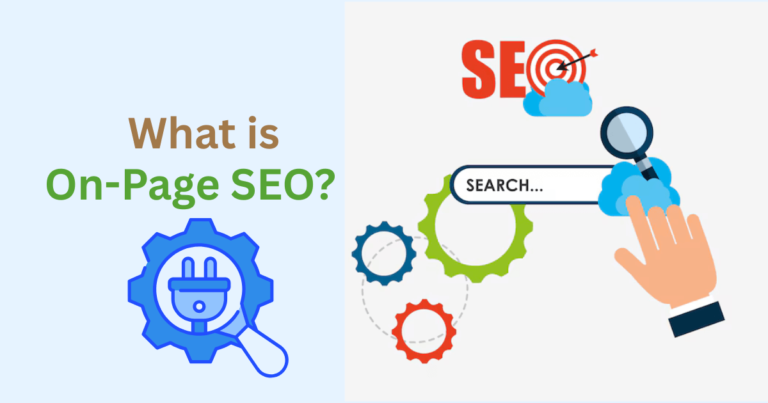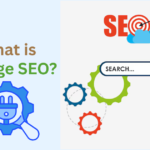Search Engine Optimization (SEO) is key in digital marketing. It helps businesses grow their online presence. Knowing the basics of SEO is important for anyone wanting to be seen online.
As people search more online, learning SEO basics is crucial. It helps businesses draw in visitors and boost sales. This guide will show why SEO matters and how it can help your website reach more people.
A well-lit, high-resolution digital illustration of a clean, minimalist design showcasing the fundamental concepts of search engine optimization (SEO). In the foreground, a simple, stylized magnifying glass icon represents the core focus on search visibility. The middle ground features a series of streamlined icons and infographic elements illustrating key SEO principles such as keyword research, content optimization, and link building. The background contains a subtle grid or wireframe pattern, conveying the technical and structured nature of effective SEO strategies. The overall mood is professional, informative, and visually engaging, suitable for use in an educational article on SEO fundamentals.
Table of Contents
Key Takeaways
- SEO is essential for improving online visibility and attracting potential customers.
- Understanding search engine algorithms is crucial for effective optimization.
- Keyword research is the foundation of successful SEO strategies.
- On-page and off-page SEO tactics work together for better results.
- Monitoring performance metrics helps gauge SEO effectiveness.
Understanding SEO and Its Importance
Search Engine Optimization (SEO) is key to making a website more visible on search engines. It uses many strategies to boost a site’s ranking and attract more visitors. Knowing the basics of SEO is crucial for anyone wanting to grow their online presence.
What is Search Engine Optimization?
SEO is about making a website more visible when people search for things online. It focuses on two main areas: how well the site matches what users are looking for, and how trustworthy it is. Good backlinks and valuable content help a site look more authoritative, which improves its ranking.
The Impact of SEO on Online Visibility
SEO has a huge impact on how visible a website is online. Using effective SEO can lead to better rankings and more visitors. For example, being on Google’s first page can get you over 70% of all clicks. Making your content search-friendly not only helps users but also boosts engagement and sales.
| SEO Tactics | Benefits |
|---|---|
| Keyword Optimization | Improves relevance for targeted searches |
| Content Quality | Engages users and reduces bounce rates |
| Mobile Optimization | Enhances accessibility for mobile users |
| Link Building | Increases authority and trustworthiness |
| Technical SEO | Ensures effective crawling and indexing |
SEO Fundamentals: Key Principles to Know
Understanding SEO is key for boosting your online presence. Two main areas to focus on are search engine algorithms and user experience. These areas greatly affect how your site ranks and how users interact with it.
Search Engine Algorithms and Ranking Factors
Search engine algorithms are complex systems that check content for relevance and authority. Many ranking factors help in this evaluation. Site speed, mobile-friendliness, and content relevance are all important.
Optimizing your site for these factors can boost your search visibility. Search engines keep updating their algorithms. This makes it crucial to stay up-to-date with SEO trends and best practices.
The Role of User Experience in SEO
User experience is a vital part of SEO. When users enjoy a website, metrics like bounce rate and dwell time improve. These metrics show how satisfied users are, which affects SEO.
Making sure visitors find useful content and navigation is easy can boost engagement. This, in turn, can improve your site’s ranking. Focusing on user experience aligns with SEO principles for better rankings.https://www.youtube.com/embed/DvwS7cV9GmQ
Keyword Research Tips for Beginners
Keyword research is key for boosting your online presence. Knowing the right keywords can make your site more visible in search engines. Using good keyword research tips helps find keywords that your audience likes. This can improve your content and digital marketing efforts.
Identifying Relevant Keywords for Your Niche
It’s important to find keywords that match your niche. Long-tail keywords are good because they have less competition and more people searching for them. They often show what users really want, leading to more engagement on your site. Here are steps to find relevant keywords:
- Think about what your audience is asking and what they need help with.
- Use Google search suggestions to find out what’s trending.
- Look at what your competitors are using to find good keywords.
- Try different versions and synonyms of your main keywords.
Tools for Effective Keyword Research
The right tools make keyword research easier. Tools like Google Keyword Planner, SEMrush, and Ahrefs give you the data you need. Here’s how these tools can help:
- Google Keyword Planner: It’s good for finding new keyword ideas based on your campaigns and market trends.
- SEMrush: It analyzes your competition, helping you find keywords that can attract more visitors.
- Ahrefs: It shows you how hard it is to rank for keywords and how many people search for them, helping with planning.
On-Page Optimization Tactics
Effective on-page optimization tactics are key to making a website more visible in search results. These strategies include creating content that is friendly to search engines, using meta tags, and optimizing images. Each step helps improve how users experience the site and its ranking in search engines.
Crafting SEO-Friendly Content
Creating content that is friendly to search engines is crucial. It must be valuable to readers and meet search engine requirements. Important steps include using the right amount of keywords, headings, and content length. Adding primary and secondary keywords naturally makes the content easier to find without losing its readability.
Meta Tags and Their Significance
Meta tags are vital in on-page optimization. Title tags should clearly show what the content is about and include main keywords. They help with click-through rates. Meta descriptions give a quick summary of the page’s content, encouraging users to visit. Making these elements work well can boost your site’s visibility in search results.
Image Optimization Best Practices
Optimizing images is important for a website’s performance. Ensuring images are the right size helps pages load faster. Adding descriptive alt text to images makes them accessible and helps with search engine visibility by adding keywords.
A modern, high-tech scene depicting various image optimization techniques. In the foreground, a computer monitor displays an array of optimization parameters, settings, and statistics, illuminated by a soft, warm glow. In the middle ground, a 3D model of a web page or mobile app interface rotates, showcasing elements like image file types, compression levels, and dimensions. In the background, a matrix of interconnected lines and nodes represents the complex algorithms and data flows involved in optimizing digital media for the web. The overall atmosphere is one of technological sophistication, data-driven problem-solving, and a commitment to delivering high-performance, visually striking digital content.
Off-Page SEO Practices
Off-page SEO practices are key to boosting a website’s authority and ranking. They focus on building credibility through external means, not just the site’s content. Building a network of backlinks and a strong online presence are crucial.
The Importance of Backlinks
Backlinks are vital for a website’s authority. When well-known sites link to yours, it shows search engines your content is reliable. Quality backlinks from trusted domains can greatly improve your site’s credibility and visibility.
Getting quality backlinks should be a top priority for any digital marketing plan.
Building a Strong Online Presence
Having a strong online presence is key to attracting visitors and improving SEO. Being active on social media lets you talk directly to your audience. Working with influencers can expand your reach and build your brand’s reputation.
Engaging online through comments and shares creates a community around your content. This supports your off-page SEO efforts.
Technical SEO Essentials
Mastering technical SEO is key to ranking well in search engines. Focus on site speed, mobile optimization, and schema markup. These areas improve organic visibility and user experience.
Site Speed and Performance Optimization
Site speed affects user engagement and search rankings. Google favors fast sites. Use tools like Google PageSpeed Insights and GTmetrix to find ways to speed up your site.
Compress images, cut down JavaScript, and use browser caching. These steps can make your site load faster.
Mobile Optimization Strategies
A website that works well on mobile is crucial today. Google now indexes mobile versions first. Make sure your site looks good on all screen sizes.
Optimize images, use mobile-specific navigation, and try AMP. These steps improve mobile user experience.
Using Schema Markup for Better Indexing
Schema markup helps search engines understand your site better. It makes your content more visible in search results. Use schema types like articles, products, or events.
This can lead to rich snippets that grab user attention. Proper schema markup boosts your site’s SEO.
Content Strategy and SEO Alignment
A good content strategy is key for SEO success. Creating high-quality content that your audience loves helps search engines see you as a trusted source. Start by making your content easy to read and full of the right keywords. This will help more people find your site.
How to Create High-Quality, SEO-Optimized Content
To make great, SEO-friendly content, follow these steps:
- Do deep research on what’s trending in your field.
- Use tools like Google Keyword Planner to find good keywords.
- Write catchy headlines that include your main keywords.
- Add images, charts, and tables to make your content better.
- Keep your content fresh by updating it often.
The Role of Blogging in SEO
Blogging for SEO is a must for any good content plan. Blogging regularly adds new content, making your site more attractive to search engines. Here’s why blogging is good for you:
- It can lead to more backlinks from other sites.
- It’s a chance to use long-tail keywords.
- It keeps users engaged with comments and shares.
- It makes your brand a go-to in your field.
Measuring SEO Success: Tools and Metrics
Knowing how to measure SEO success is key for better strategies. The right tools and metrics help track your progress. They guide you in making smart choices. Accurate checks depend on picking the right key performance indicators that match your goals.
Key Performance Indicators (KPIs) to Monitor
Tracking specific KPIs shows how well your website is doing. Important metrics include:
- Organic Traffic: The number of visitors from search engines shows your visibility.
- Bounce Rate: High bounce rates mean your content might not meet user needs.
- Conversion Rates: This shows how many visitors take the actions you want, showing your site’s success.
Using Google Analytics for SEO Insights
Google Analytics is a great tool for analyzing user data and behavior. Use it to set up specific goals for tracking conversions. Regularly check reports on user acquisition, behavior, and conversions.
By understanding these metrics, you can tweak your SEO strategies for better results.
A well-lit, high-resolution image of a professional digital workplace, with a sleek white desk in the foreground displaying a laptop, smartphone, and various office supplies. In the middle ground, a visual dashboard showcases real-time SEO metrics and analytics, represented by colorful graphs, charts, and performance indicators. The background features a minimalist office setting, with large windows letting in natural light and a city skyline visible outside. The overall mood is one of efficiency, focus, and data-driven decision-making, reflecting the successful measurement of SEO performance.
Staying Current: SEO Best Practices
In the fast-changing world of search engine optimization, it’s key to keep up with new trends and updates. SEO is always evolving, so staying ahead is crucial. By following the best practices, you can boost your online presence and keep your strategies up-to-date.
Following Industry Trends and Updates
Search engine algorithms change often, affecting how websites rank in search results. Staying informed about these changes helps marketers adjust their plans. Through ongoing learning, professionals can adapt to these shifts, making their strategies more effective.
The Impact of Social Media on SEO
Social media and SEO are more connected than ever. Social signals like likes and shares can boost a website’s ranking. Brands that use social media well can attract more visitors, improving their visibility. Combining social media with SEO can help connect with audiences better, leading to growth.
Conclusion
In this article, we’ve covered the basics of SEO and how it affects your online presence. We looked at important strategies like keyword research and technical optimization. These are key for anyone wanting to boost their website’s search ranking.
Our main points show that SEO is a continuous effort. It’s not a one-time task but a process that needs constant improvement. By using the strategies we discussed, you can improve your online visibility. This can lead to more user engagement and success in your field.
Remember, the digital world is always shifting. Keeping up with SEO changes is essential for better rankings. The path to mastering SEO is long, but the benefits are worth it for your online projects.
FAQ
What are the SEO fundamentals I need to know?
SEO basics include understanding how search engines work and the role of keywords. You also need to know about on-page and off-page optimization. Plus, keeping an eye on your website’s performance is key.
Why is keyword research critical for SEO?
Keyword research is key because it finds the terms people search for online. By using these keywords, your content becomes more relevant. This leads to more visitors and better rankings.
What are some on-page optimization tactics I should implement?
Good on-page tactics include making your content SEO-friendly and optimizing meta tags. Use header tags and ensure images are optimized. These steps make your content easier to find.
How do I build quality backlinks for off-page SEO?
To get quality backlinks, create content worth sharing and engage with influencers. Also, write guest posts for reputable blogs. These actions boost your site’s authority and rankings.
What are the best practices for improving site speed?
To speed up your site, optimize images and reduce server time. Enable compression and cut down on HTTP requests. Tools like Google PageSpeed Insights can guide you.
How does mobile optimization affect SEO?
Mobile optimization is crucial because search engines favor mobile-friendly sites. A responsive design ensures a good user experience on all devices. This can lead to better rankings.
What tools can help with measuring SEO success?
For tracking SEO success, use Google Analytics, SEMrush, and Ahrefs. These tools offer insights into traffic, keywords, and user behavior. They help refine your SEO plans.
What is the role of blogging in SEO?
Blogging is essential for SEO as it provides fresh content. This attracts backlinks and improves rankings. Regular blog posts also help with long-tail keywords.
How can I align my content strategy with SEO?
Align your content with SEO by creating high-quality, keyword-rich content. Analyze performance to improve your strategy. Focus on meeting user needs and trends.
What are some current trends in SEO I should know about?
Stay updated with SEO trends like voice search and Core Web Vitals. Video content is also becoming more important. Keeping up with these trends can boost your site’s visibility.












